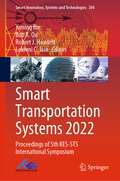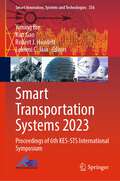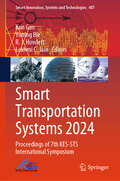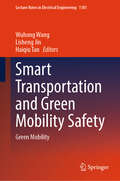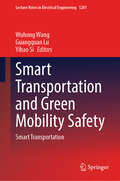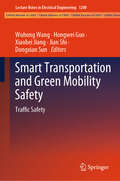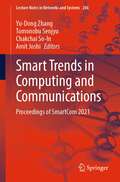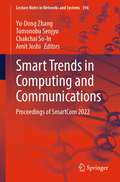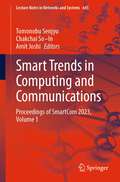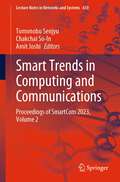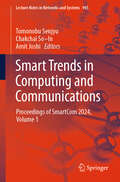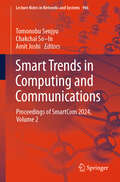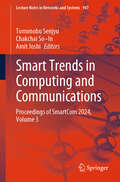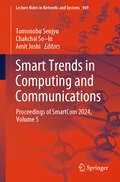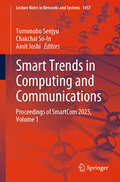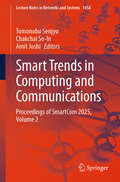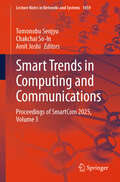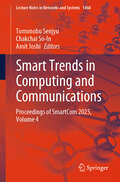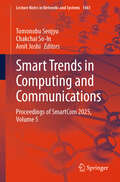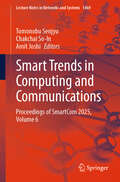- Table View
- List View
Smart Transportation Systems 2020: Proceedings of 3rd KES-STS International Symposium (Smart Innovation, Systems and Technologies #185)
by Lakhmi C. Jain Robert J. Howlett Xiaobo Qu Lu ZhenThis book gathers selected papers presented at the KES International Symposium on Smart Transportation Systems (KES STS 2020). Modern transportation systems have undergone a rapid transformation in recent years, producing a range of technological innovations such as connected vehicles, self-driving cars, electric vehicles, Hyperloop, and even flying cars, and with them, fundamental changes in transport systems around the world. The book discusses current challenges, innovations, and breakthroughs in smart transportation systems, as well as transport infrastructure modeling, safety analysis, freeway operations, intersection analysis, and other related cutting-edge topics.
Smart Transportation Systems 2021: Proceedings of 4th KES-STS International Symposium (Smart Innovation, Systems and Technologies #231)
by Lakhmi C. Jain Robert J. Howlett Xiaobo Qu Lu ZhenThis book gathers selected papers presented at the KES International Symposium on Smart Transportation Systems (KES-STS 2021). Modern transportation systems have undergone a rapid transformation in recent years, producing a range of technological innovations such as connected vehicles, self-driving cars, electric vehicles, Hyperloop, and even flying cars, and with them, fundamental changes in transport systems around the world. The book discusses current challenges, innovations, and breakthroughs in smart transportation systems, as well as transport infrastructure modelling, safety analysis, freeway operations, intersection analysis, and other related cutting-edge topics.
Smart Transportation Systems 2022: Proceedings of 5th KES-STS International Symposium (Smart Innovation, Systems and Technologies #304)
by Lakhmi C. Jain Robert J. Howlett Yiming Bie Bob X. QuThis book gathers selected papers presented at the KES International Symposium on Smart Transportation Systems (KES STS 2022). Modern transportation systems have undergone a rapid transformation in recent years, producing a range of technological innovations such as connected vehicles, self-driving cars, electric vehicles, Hyperloop, and even flying cars, and with them, fundamental changes in transport systems around the world. The book discusses current challenges, innovations, and breakthroughs in smart transportation systems, as well as transport infrastructure modeling, safety analysis, freeway operations, intersection analysis, and other related cutting-edge topics.
Smart Transportation Systems 2023: Proceedings of 6th KES-STS International Symposium (Smart Innovation, Systems and Technologies #356)
by Lakhmi C. Jain Robert J. Howlett Kun Gao Yiming BieThis book gathers selected papers presented at the KES International Symposium on Smart Transportation Systems (KES STS 2023). Modern transportation systems have undergone a rapid transformation in recent years, producing a range of technological innovations such as connected vehicles, self-driving cars, electric vehicles, Hyperloop, and even flying cars, and with them, fundamental changes in transport systems around the world. The book discusses current challenges, innovations, and breakthroughs in smart transportation systems, as well as transport infrastructure modeling, safety analysis, freeway operations, intersection analysis, and other related cutting-edge topics.
Smart Transportation Systems 2024: Proceedings of 7th KES-STS International Symposium (Smart Innovation, Systems and Technologies #407)
by Lakhmi C. Jain Kun Gao R. J. Howlett Yiming BieThis book gathers selected papers presented at the KES International Symposium on Smart Transportation Systems (KES STS 2024). Modern transportation systems have undergone a rapid transformation in recent years, producing a range of technological innovations such as connected vehicles, self-driving cars, electric vehicles, Hyperloop, and even flying cars, and with them, fundamental changes in transport systems around the world. The book discusses current challenges, innovations, and breakthroughs in smart transportation systems, as well as transport infrastructure modeling, safety analysis, freeway operations, intersection analysis, and other related cutting-edge topics.
Smart Transportation and Green Mobility Safety: Green Mobility (Lecture Notes in Electrical Engineering #1181)
by Wuhong Wang Lisheng Jin Haiqiu TanThis book gathers selected papers from the 13th International Conference on Green Intelligent Transportation Systems and Safety, held in Qinghuadao, China, on September 16-18, 2022. It presents cutting-edge studies on Green Intelligent Mobility Systems, with the guiding motto being to achieve "green, intelligent, and safe transportation systems". The book presented here helps promote the development of green mobility and intelligent transportation technologies to improve interconnectivity, resource sharing, flexibility, and efficiency. Given its scope, the book benefits researchers and engineers in the fields of Transportation Technology and Traffic Engineering, Automotive and Mechanical Engineering, Industrial and System Engineering, and Electrical Engineering alike. Readers will be able to learn about the advances in green intelligent transportation systems and safety.
Smart Transportation and Green Mobility Safety: Smart Transportation (Lecture Notes in Electrical Engineering #1201)
by Wuhong Wang Guangquan Lu Yihao SiThis book gathers selected papers from the 13th International Conference on Green Intelligent Transportation Systems and Safety, held in Qinghuadao, China, on September 16–18, 2022. It presents cutting-edge studies on Green Intelligent Mobility Systems, with the guiding motto being to achieve “green, intelligent, and safe transportation systems”. The book presented here helps promote the development of green mobility and intelligent transportation technologies to improve interconnectivity, resource sharing, flexibility, and efficiency. Given its scope, the book benefits researchers and engineers in the fields of Transportation Technology and Traffic Engineering, Automotive and Mechanical Engineering, Industrial and System Engineering, and Electrical Engineering alike. Readers will be able to learn about the advances in green intelligent transportation systems and safety.
Smart Transportation and Green Mobility Safety: Traffic Safety (Lecture Notes in Electrical Engineering #1200)
by Wuhong Wang Xiaobei Jiang Hongwei Guo Jian Shi Dongxian SunThis book gathers selected papers from the 13th International Conference on Green Intelligent Transportation Systems and Safety, held in Qinghuadao, China, on September 16-18, 2022. It presents cutting-edge studies on Green Intelligent Mobility Systems, with the guiding motto being to achieve "green, intelligent, and safe transportation systems". The book presented here helps promote the development of green mobility and intelligent transportation technologies to improve interconnectivity, resource sharing, flexibility, and efficiency. Given its scope, the book benefits researchers and engineers in the fields of Transportation Technology and Traffic Engineering, Automotive and Mechanical Engineering, Industrial and System Engineering, and Electrical Engineering alike. Readers will be able to learn about the advances in green intelligent transportation systems and safety.
Smart Trends in Computing and Communications: Proceedings of SmartCom 2020 (Smart Innovation, Systems and Technologies #182)
by Amit Joshi Yu-Dong Zhang Tomonoby Senjyu Chakchai So–inThis book gathers high-quality papers presented at the International Conference on Smart Trends for Information Technology and Computer Communications (SmartCom 2020), organized by the Global Knowledge Research Foundation (GR Foundation) from 23 to 24 January 2020. It covers the state-of-the-art and emerging topics in information, computer communications, and effective strategies for their use in engineering and managerial applications. It also explores and discusses the latest technological advances in, and future directions for, information and knowledge computing and its applications.
Smart Trends in Computing and Communications: Proceedings of SmartCom 2021 (Lecture Notes in Networks and Systems #286)
by Amit Joshi Yu-Dong Zhang Tomonobu Senjyu Chakchai So-InThis book gathers high-quality papers presented at the Fifth International Conference on Smart Trends in Computing and Communications (SmartCom 2021), organized by Global Knowledge Research Foundation (GR Foundation) from March 2 – 3 , 2021. It covers the state of the art and emerging topics in information, computer communications, and effective strategies for their use in engineering and managerial applications. It also explores and discusses the latest technological advances in, and future directions for, information and knowledge computing and its applications.
Smart Trends in Computing and Communications: Proceedings of SmartCom 2022 (Lecture Notes in Networks and Systems #396)
by Amit Joshi Yu-Dong Zhang Tomonobu Senjyu Chakchai So-InThis book gathers high-quality papers presented at the Sixth International Conference on Smart Trends in Computing and Communications (SmartCom 2022), organized by Global Knowledge Research Foundation (GR Foundation) in partnership with IFIP InterYIT during January 11–12, 2022. It covers the state of the art and emerging topics in information, computer communications, and effective strategies for their use in engineering and managerial applications. It also explores and discusses the latest technological advances in, and future directions for, information and knowledge computing and its applications.
Smart Trends in Computing and Communications: Proceedings of SmartCom 2023, Volume 1 (Lecture Notes in Networks and Systems #645)
by Amit Joshi Tomonobu Senjyu Chakchai So–InThis book gathers high-quality papers presented at the Seventh International Conference on Smart Trends in Computing and Communications (SmartCom 2022), organized by Global Knowledge Research Foundation (GR Foundation) from January 24–25, 2023, in Jaipur, India. It covers the state-of-the-art and emerging topics in information, computer communications, and effective strategies for their use in engineering and managerial applications. It also explores and discusses the latest technological advances in, and future directions for, information and knowledge computing and its applications.
Smart Trends in Computing and Communications: Proceedings of SmartCom 2023, Volume 2 (Lecture Notes in Networks and Systems #650)
by Amit Joshi Tomonobu Senjyu Chakchai So-InThis book gathers high-quality papers presented at the Seventh International Conference on Smart Trends in Computing and Communications (SmartCom 2022), organized by Global Knowledge Research Foundation (GR Foundation) from January 24–25, 2023, in Jaipur, India. It covers the state-of-the-art and emerging topics in information, computer communications, and effective strategies for their use in engineering and managerial applications. It also explores and discusses the latest technological advances in, and future directions for, information and knowledge computing and its applications.
Smart Trends in Computing and Communications: Proceedings of SmartCom 2024, Volume 1 (Lecture Notes in Networks and Systems #945)
by Amit Joshi Tomonobu Senjyu Chakchai So–InThis book gathers high-quality papers presented at the Eighth International Conference on Smart Trends in Computing and Communications (SmartCom 2024), organized by Global Knowledge Research Foundation (GR Foundation) from 12 to 13 January 2024 in Pune, India. It covers the state-of-the-art and emerging topics in information, computer communications, and effective strategies for their use in engineering and managerial applications. It also explores and discusses the latest technological advances in, and future directions for, information and knowledge computing and its applications.
Smart Trends in Computing and Communications: Proceedings of SmartCom 2024, Volume 2 (Lecture Notes in Networks and Systems #946)
by Amit Joshi Tomonobu Senjyu Chakchai So–InThis book gathers high-quality papers presented at the Eighth International Conference on Smart Trends in Computing and Communications (SmartCom 2024), organized by Global Knowledge Research Foundation (GR Foundation) from 12 to 13 January 2024 in Pune, India. It covers the state-of-the-art and emerging topics in information, computer communications, and effective strategies for their use in engineering and managerial applications. It also explores and discusses the latest technological advances in, and future directions for, information and knowledge computing and its applications.
Smart Trends in Computing and Communications: Proceedings of SmartCom 2024, Volume 3 (Lecture Notes in Networks and Systems #947)
by Amit Joshi Tomonobu Senjyu Chakchai So–InThis book gathers high-quality papers presented at the Eighth International Conference on Smart Trends in Computing and Communications (SmartCom 2024), organized by Global Knowledge Research Foundation (GR Foundation) from 12 to 13 January 2024 in Pune, India. It covers the state-of-the-art and emerging topics in information, computer communications, and effective strategies for their use in engineering and managerial applications. It also explores and discusses the latest technological advances in, and future directions for, information and knowledge computing and its applications.
Smart Trends in Computing and Communications: Proceedings of SmartCom 2024, Volume 4 (Lecture Notes in Networks and Systems #948)
by Amit Joshi Tomonobu Senjyu Chakchai So–InThis book gathers high-quality papers presented at the Eighth International Conference on Smart Trends in Computing and Communications (SmartCom 2024), organized by Global Knowledge Research Foundation (GR Foundation) from 12 to 13 January 2024 in Pune, India. It covers the state-of-the-art and emerging topics in information, computer communications, and effective strategies for their use in engineering and managerial applications. It also explores and discusses the latest technological advances in, and future directions for, information and knowledge computing and its applications.
Smart Trends in Computing and Communications: Proceedings of SmartCom 2024, Volume 5 (Lecture Notes in Networks and Systems #949)
by Amit Joshi Tomonobu Senjyu Chakchai So–InThis book gathers high-quality papers presented at the Eighth International Conference on Smart Trends in Computing and Communications (SmartCom 2024), organized by Global Knowledge Research Foundation (GR Foundation) from 12 to 13 January 2024 in Pune, India. It covers the state-of-the-art and emerging topics in information, computer communications, and effective strategies for their use in engineering and managerial applications. It also explores and discusses the latest technological advances in, and future directions for, information and knowledge computing and its applications.
Smart Trends in Computing and Communications: Proceedings of SmartCom 2025, Volume 1 (Lecture Notes in Networks and Systems #1457)
by Amit Joshi Tomonobu Senjyu Chakchai So-InThis book gathers high-quality papers presented at the Ninth International Conference on Smart Trends in Computing and Communications (SmartCom 2025), organised by Global Knowledge Research Foundation (GR Foundation) from 29 to 31 January 2025 in Pune, India. It covers state-of-the-art and emerging topics in information, computer communications, and effective strategies for their use in engineering and managerial applications. It also explores and discusses the latest technological advances in, and future directions for, information and knowledge computing and its applications.
Smart Trends in Computing and Communications: Proceedings of SmartCom 2025, Volume 10 (Lecture Notes in Networks and Systems #1465)
by Amit Joshi Tomonobu Senjyu Chakchai So-InThis book gathers high-quality papers presented at the Ninth International Conference on Smart Trends in Computing and Communications (SmartCom 2025), organised by Global Knowledge Research Foundation (GR Foundation) from 29 to 31 January 2025 in Pune, India. It covers state-of-the-art and emerging topics in information, computer communications, and effective strategies for their use in engineering and managerial applications. It also explores and discusses the latest technological advances in, and future directions for, information and knowledge computing and its applications.
Smart Trends in Computing and Communications: Proceedings of SmartCom 2025, Volume 2 (Lecture Notes in Networks and Systems #1458)
by Amit Joshi Tomonobu Senjyu Chakchai So-InThis book gathers high-quality papers presented at the Ninth International Conference on Smart Trends in Computing and Communications (SmartCom 2025), organised by Global Knowledge Research Foundation (GR Foundation) from 29 to 31 January 2025 in Pune, India. It covers state-of-the-art and emerging topics in information, computer communications, and effective strategies for their use in engineering and managerial applications. It also explores and discusses the latest technological advances in, and future directions for, information and knowledge computing and its applications.
Smart Trends in Computing and Communications: Proceedings of SmartCom 2025, Volume 3 (Lecture Notes in Networks and Systems #1459)
by Amit Joshi Tomonobu Senjyu Chakchai So-InThis book gathers high-quality papers presented at the Ninth International Conference on Smart Trends in Computing and Communications (SmartCom 2025), organised by Global Knowledge Research Foundation (GR Foundation) from 29 to 31 January 2025 in Pune, India. It covers state-of-the-art and emerging topics in information, computer communications, and effective strategies for their use in engineering and managerial applications. It also explores and discusses the latest technological advances in, and future directions for, information and knowledge computing and its applications.
Smart Trends in Computing and Communications: Proceedings of SmartCom 2025, Volume 4 (Lecture Notes in Networks and Systems #1460)
by Amit Joshi Tomonobu Senjyu Chakchai So-InThis book gathers high-quality papers presented at the Ninth International Conference on Smart Trends in Computing and Communications (SmartCom 2025), organised by Global Knowledge Research Foundation (GR Foundation) from 29 to 31 January 2025 in Pune, India. It covers state-of-the-art and emerging topics in information, computer communications, and effective strategies for their use in engineering and managerial applications. It also explores and discusses the latest technological advances in, and future directions for, information and knowledge computing and its applications.
Smart Trends in Computing and Communications: Proceedings of SmartCom 2025, Volume 5 (Lecture Notes in Networks and Systems #1461)
by Amit Joshi Tomonobu Senjyu Chakchai So-InThis book gathers high-quality papers presented at the Ninth International Conference on Smart Trends in Computing and Communications (SmartCom 2025), organised by Global Knowledge Research Foundation (GR Foundation) from 29 to 31 January 2025 in Pune, India. It covers state-of-the-art and emerging topics in information, computer communications, and effective strategies for their use in engineering and managerial applications. It also explores and discusses the latest technological advances in, and future directions for, information and knowledge computing and its applications.
Smart Trends in Computing and Communications: Proceedings of SmartCom 2025, Volume 6 (Lecture Notes in Networks and Systems #1469)
by Amit Joshi Tomonobu Senjyu Chakchai So-InThis book gathers high-quality papers presented at the Ninth International Conference on Smart Trends in Computing and Communications (SmartCom 2025), organised by Global Knowledge Research Foundation (GR Foundation) from 29 to 31 January 2025 in Pune, India. It covers state-of-the-art and emerging topics in information, computer communications, and effective strategies for their use in engineering and managerial applications. It also explores and discusses the latest technological advances in, and future directions for, information and knowledge computing and its applications.


